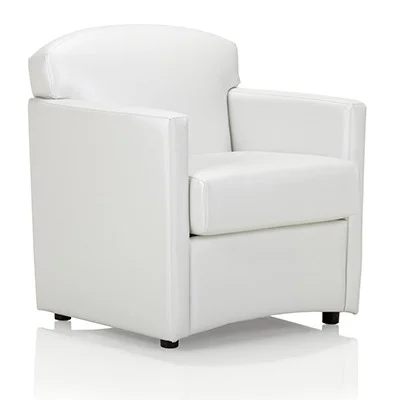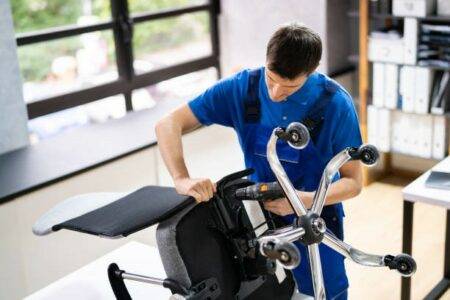The Importance of Ergonomics
As a business owner or government employee, understanding the impact of ergonomics on your work environment is essential. Not only does it contribute to the comfort and well-being of your staff, but it also plays a significant role in their productivity and performance.
Understanding Ergonomics
Ergonomics is the study of how to design and arrange things people use so that the individuals and things interact most efficiently and safely. It takes into account the physical capabilities and limits of the human body. An ergonomic chair, for instance, is designed to support the natural curvature of the spine and reduce strain on the body, allowing the user to maintain a comfortable and healthy posture over prolonged periods of sitting.
In an office setting, ergonomics encompasses everything from the layout of the workstation to the design of the furniture. The goal is to create a workspace that promotes good posture, reduces the risk of injury, and enhances productivity. To know more about ergonomic chairs, you can refer to our article on ergonomic office chair.
The Role of Ergonomics in the Workplace
Ergonomics plays a crucial role in the workplace. By optimizing your office environment for the comfort and well-being of your employees, you can reap a host of benefits. For instance, an ergonomic environment can lead to increased productivity, improved job satisfaction, and reduced absenteeism due to health problems.
One of the key aspects of workplace ergonomics is seating. An ergonomic chair can significantly improve the comfort of your employees, especially those who spend long hours at their desks. These chairs are designed to support the user’s body in a manner that minimizes strain and promotes good posture. For more insight, you can visit our article on ergonomic seating.
Investing in ergonomic seating solutions can result in substantial long-term benefits for your organization. Not only can it improve the health and well-being of your employees, but it can also enhance their performance and productivity. If you’re interested in exploring more about the importance of ergonomics in different contexts, feel free to browse through our resources on ergonomic seating for work, ergonomic seating for gaming, and ergonomic seating for seniors.
Exploring Ergonomic Chairs
Navigating the realm of office furniture can often seem daunting, especially if you are not familiar with the term “ergonomic chair“. In this section, we will demystify what an ergonomic chair is and highlight its key features.
What is an Ergonomic Chair?
An ergonomic chair is a type of seating specifically designed to support the natural alignment of the body. The primary goal of this chair is to provide optimal comfort and reduce the risk of musculoskeletal disorders and other conditions that may arise from prolonged sitting.
Unlike standard office chairs, ergonomic chairs are highly adjustable to accommodate a wide range of body shapes and sizes. They’re designed to promote good posture, proper circulation, and efficient movement, which can be beneficial for those spending long hours seated at a desk. Explore more about the ergonomic office chair in our comprehensive guide.
Key Features of an Ergonomic Chair
While the design and features of an ergonomic chair may vary, there are several key elements that you should look for:
Adjustable Seat Height: An important feature of an ergonomic chair is its adjustable seat height. This allows you to properly align your feet flat on the floor, with your thighs horizontal and arms even with the height of the desk.
Seat Depth and Width: The seat should have enough depth and width to support any user comfortably. Ideally, it should be deep enough so that your back is against the chair’s backrest while leaving a gap of approximately 2-4 inches between the back of the knees and the chair’s seat.
Lumbar Support: A good ergonomic chair will have lumbar support for the lower back. This is crucial in preventing back strain that can worsen into debilitating conditions like sciatica.
Backrest: The backrest of an ergonomic chair should be adjustable in both height and angle. It should be able to support the natural curve of the spine, providing support for the lumbar region.
Armrests: Adjustable armrests are another crucial feature. When your arms are resting, the elbows and lower arms should rest lightly, freeing the shoulders from strain.
Swivel: A swivel feature allows for easy rotation, enabling you to reach different areas of your workspace without straining.
| Feature | Description |
|---|---|
| Adjustable Seat Height | Aligns your feet flat on the floor, thighs horizontal, and arms even with the desk height. |
| Seat Depth and Width | Provides enough support for any user comfortably. |
| Lumbar Support | Prevents back strain and supports the lower back. |
| Backrest | Adjustable in both height and angle to support the natural curve of the spine. |
| Armrests | Adjustable to rest the elbows and lower arms lightly, freeing the shoulders from strain. |
| Swivel | Allows for easy rotation to reach different areas without straining. |
By understanding the features and benefits of ergonomic chairs, you can make informed decisions for your office seating. Whether it’s for work, gaming, or even for seniors, children, or during pregnancy, the right ergonomic seating can significantly improve comfort and productivity. Explore more on our guides to ergonomic seating solutions for different needs.
Benefits of Ergonomic Chairs
Opting for an ergonomic chair can offer a range of benefits that can significantly improve your physical and mental health. When used correctly, these chairs can enhance your overall well-being and productivity. Let’s delve into these advantages.
Physical Health Benefits
Improved Posture
An ergonomic chair is designed to support the natural position of your body, promoting a healthier posture. It encourages you to sit upright and supports your lower back, reducing the tendency to slouch. This can lead to a notable improvement in your overall posture, not just when you’re sitting. Check out our article on ergonomic seating for posture for more insights.
Reduced Risk of Back Pain
Ergonomic chairs are equipped with features such as lumbar support and adjustable seat height, backrest, and armrests. These can reduce the pressure and strain on your spine, decreasing the risk of developing back pain. If you’re already experiencing back discomfort, an ergonomic office chair can help alleviate it.
Enhanced Blood Circulation
The adjustable features of an ergonomic chair allow you to achieve an optimal seating position, where your feet are flat on the floor and your knees are at a 90-degree angle. This position promotes better blood circulation, reducing the risk of swelling and varicose veins in your legs.
Mental Health Benefits
Increased Productivity
When you’re comfortable in your workspace, it’s easier to focus on tasks and maintain productivity. An ergonomic chair can reduce discomfort and distractions, allowing you to concentrate better and achieve more in your workday. For more on this, explore our article on ergonomic seating for work.
Reduced Stress and Fatigue
By promoting a healthier sitting position and reducing physical discomfort, ergonomic chairs can also help lower stress levels and combat fatigue. As your body is less strained, you’re likely to have more energy throughout the day, leading to a more efficient and enjoyable work experience.
In conclusion, the health benefits of ergonomic chairs extend beyond the immediate comfort they provide. By investing in an ergonomic seating solution, you’re investing in the long-term health and productivity of yourself and your team. Whether you’re looking for an ergonomic desk chair for your home office or exploring ergonomic seating solutions for a large workspace, consider the benefits described here in your decision-making process.
Implementing Ergonomic Chairs in the Workplace
Making the switch to ergonomic seating in the workplace is an investment in the health and productivity of your workforce. It involves assessing your current seating, transitioning to ergonomic seating, and training your employees on proper usage.
Assessing Your Current Seating
Take a look around your workspace. What kind of chairs are your employees using? Are they comfortable, adjustable, and supportive? If your current seating options do not promote good posture and comfort, it might be time to consider an upgrade.
The first step in your switch to ergonomic seating is to evaluate your current chairs. Assess them for factors such as adjustability, support, and comfort. Non-ergonomic chairs often lack sufficient back support, have non-adjustable seat heights, and may not provide adequate comfort for long periods of sitting.
Transitioning to Ergonomic Seating
Once you’ve assessed your current seating, the next step is to transition to ergonomic chairs. The ergonomic chair is designed to provide maximum support and comfort during long sitting periods. Its key features include adjustable seat height, backrest, armrests, and adequate lumbar support.
While transitioning, keep in mind the diverse needs of your employees. The ideal chair for one may not work for another. Hence, it’s important to choose adjustable chairs that cater to various body types and work styles. Also, consider the tasks your employees perform. For example, someone spending a lot of time at a computer might need a different ergonomic solution compared to someone who is frequently up and moving around.
Training Employees on Proper Usage
Investing in ergonomic chairs is only part of the equation. It’s equally important to ensure your employees know how to properly adjust and use these chairs to reap the full benefits.
Conduct training sessions to educate your employees on the importance of ergonomics and how to adjust their new chairs to fit their bodies and workstations. This training should cover aspects like setting the correct seat height, adjusting the backrest, and positioning the armrests.
Remember, an ergonomic chair can only do its job if it’s used correctly. Therefore, make sure your employees understand how to make the most of this investment.
By implementing ergonomic seating in your workplace, you’re not only investing in the comfort of your employees but also their health, productivity, and overall job satisfaction.
For more information on selecting the right chairs, check out our guide on ergonomic seating solutions. And if you’re interested in exploring the benefits of ergonomic seating further, our articles on ergonomic seating for work and ergonomic seating for posture might be of interest.
Common Misconceptions About Ergonomic Chairs
In the quest to improve workplace comfort and productivity, it’s critical to separate fact from fiction. Below, we debunk common misconceptions about ergonomic chairs and provide insight on how to maximize the benefits of your ergonomic chair.
Debunking Myths
Myth 1: One Size Fits All
Contrary to popular belief, there’s no ‘one size fits all’ when it comes to ergonomic chairs. Everyone’s body is unique and requires different levels of support. An ergonomic chair that works perfectly for one person may not work for another. When choosing an ergonomic office chair, it’s crucial to find one that fits your body shape and size, and can be adjusted to meet your specific needs.
Myth 2: The More Adjustments, The Better
While it’s true that adjustability is a key feature of ergonomic chairs, more isn’t always better. The most important thing is to have adjustments that truly matter and contribute to comfort and support. These include chair height, backrest angle, and armrest positioning. Excessive features can complicate usage and distract from the chair’s main purpose: providing proper support.
Myth 3: Ergonomic Chairs Completely Eliminate Back Pain
Though an ergonomic desk chair can significantly reduce the risk of back pain by promoting proper posture, it’s not a magic solution. It’s essential to pair your ergonomic seating with regular breaks and stretching exercises.
Making the Most of Your Ergonomic Chair
Once you’ve chosen the right ergonomic chair, it’s essential to know how to use it properly to reap its benefits. Here are some tips on maximizing the potential of your ergonomic chair:
Adjust Your Chair: Start by adjusting your chair to fit your body dimensions. The chair height should allow your feet to rest flat on the ground, and your knees should be at a 90-degree angle. The backrest should follow the natural curve of your spine, and the armrests should support your arms without causing shoulder strain.
Maintain Good Posture: Always try to maintain good posture while sitting. Keep your back straight, shoulders relaxed, and refrain from slouching. This will help to reduce strain on your back and neck.
Take Regular Breaks: Even with the best ergonomic chair, it’s essential to take regular breaks to stretch and move your body. This will help to prevent muscle stiffness and improve circulation.
Pair with Other Ergonomic Furniture: An ergonomic chair works best in conjunction with other ergonomic furniture, such as an adjustable desk and a well-positioned monitor. This will ensure a fully ergonomic workspace that promotes good posture and minimizes strain.
By debunking the myths and understanding how to properly use an ergonomic chair, you can significantly improve your comfort, productivity, and overall health in the workplace. Whether you’re exploring ergonomic seating for gaming, ergonomic seating for pregnancy or ergonomic seating for seniors, understanding the facts about ergonomic chairs is key to making an informed decision.




















; ?>/theme/img/ecl.jpg)